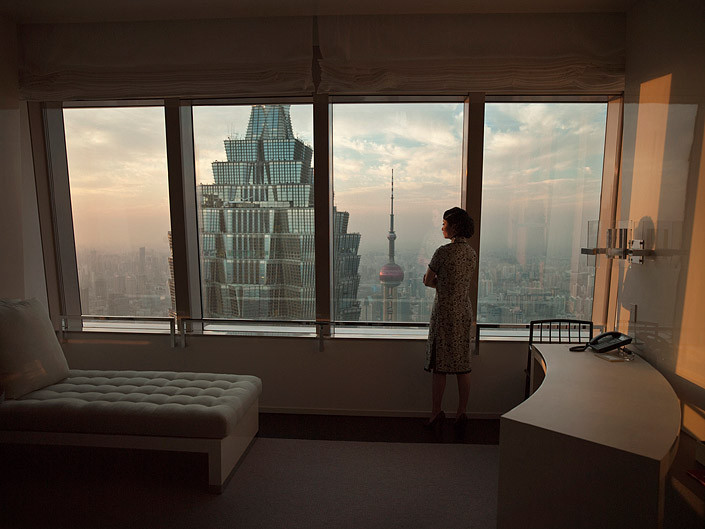Isaac Julien
19 May - 15 Jul 2011
ISAAC JULIEN
Ten Thousand Waves
19 May - 15 July, 2011
The most recent film work by Isaac Julien (London, 2960) is a 9-screen installation filmed in natural locations in the famous Chinese region of Guanxi. Over more than 4 years, the British artist has reflected on a theme central to his work: the relationship between man and his environment, whether physical, social or cultural.
The project is based on a true story, the tragedy of Morecambe Bay, in Northern England, where 23 cockle pickers, all coming from the same village in China, died. Based on this event, Julien starts developing different lines of thought, converging in a final result which combines the tragedy of immigration, the fascination with the thousand-year-old Chinese culture, or travel understood as a path towards transformation and learning.
The narrative alternates, with a poetic tone, different stories connected to each other, that show the past and present of China. Thus Julien can also reflect about the different aesthetic languages associated with those moments, by mixing reality and fiction (recordings of surveillance cameras along with a narrative film that takes us back to the classic Golden Age of film at the legendary studios of Shanghai). The piece tells a true story, but also offers an essay on the human condition and a dramatic fiction that is almost a fairy tale.
Julien uses the 16th-century legend of the goddess Mazu, from the same geographical area where the drowned cockle pickers drowned in Morecambe in England came from. In the original story, the goddess is saved by a fisherman, and in its adaptation, the artist turns it into the central plot of the piece, and uses it in order to transcend temporal and physical limits.
The artist has had exceptional collaborators, such as actress Maggie Cheung, visual artist Yan Fudong, or calligrapher Gong Fagen, and provides a throughput for all the obsessions that have beset him during the preparation of this project: contemporary China with its perpetually growing cities, or the weight of traditional Chinese culture, and human and spiritual tragedy.
But, undoubtedly, the key element of the work is the narrative itself, which alternates traditional reverse shots and the cut provided by combining the 9 screens in a setup reminiscent of the experience of Abel Gance and which, while having been researched by Julien for years, reaches its peak here.
This video installation, co-produced by Galería Helga de Alvear, was presented in the last Sydney Biennale, and has been shown at the Bas Museum, Miami, at the Brandhorst Museum, Munich, and at the Hayward Gallery in London.
Ten Thousand Waves
19 May - 15 July, 2011
The most recent film work by Isaac Julien (London, 2960) is a 9-screen installation filmed in natural locations in the famous Chinese region of Guanxi. Over more than 4 years, the British artist has reflected on a theme central to his work: the relationship between man and his environment, whether physical, social or cultural.
The project is based on a true story, the tragedy of Morecambe Bay, in Northern England, where 23 cockle pickers, all coming from the same village in China, died. Based on this event, Julien starts developing different lines of thought, converging in a final result which combines the tragedy of immigration, the fascination with the thousand-year-old Chinese culture, or travel understood as a path towards transformation and learning.
The narrative alternates, with a poetic tone, different stories connected to each other, that show the past and present of China. Thus Julien can also reflect about the different aesthetic languages associated with those moments, by mixing reality and fiction (recordings of surveillance cameras along with a narrative film that takes us back to the classic Golden Age of film at the legendary studios of Shanghai). The piece tells a true story, but also offers an essay on the human condition and a dramatic fiction that is almost a fairy tale.
Julien uses the 16th-century legend of the goddess Mazu, from the same geographical area where the drowned cockle pickers drowned in Morecambe in England came from. In the original story, the goddess is saved by a fisherman, and in its adaptation, the artist turns it into the central plot of the piece, and uses it in order to transcend temporal and physical limits.
The artist has had exceptional collaborators, such as actress Maggie Cheung, visual artist Yan Fudong, or calligrapher Gong Fagen, and provides a throughput for all the obsessions that have beset him during the preparation of this project: contemporary China with its perpetually growing cities, or the weight of traditional Chinese culture, and human and spiritual tragedy.
But, undoubtedly, the key element of the work is the narrative itself, which alternates traditional reverse shots and the cut provided by combining the 9 screens in a setup reminiscent of the experience of Abel Gance and which, while having been researched by Julien for years, reaches its peak here.
This video installation, co-produced by Galería Helga de Alvear, was presented in the last Sydney Biennale, and has been shown at the Bas Museum, Miami, at the Brandhorst Museum, Munich, and at the Hayward Gallery in London.

